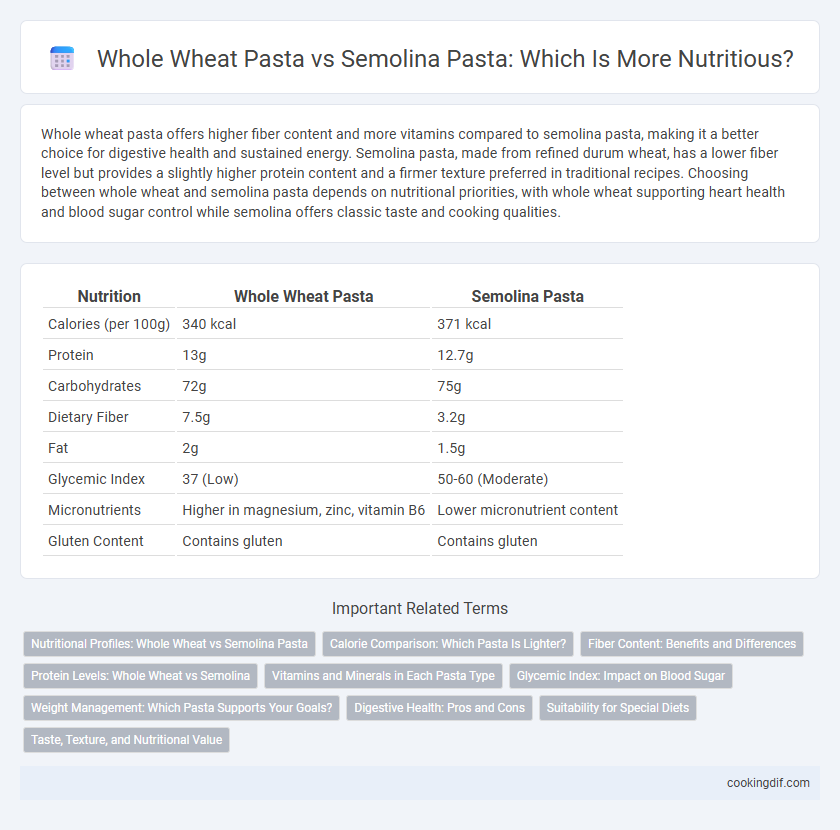Whole wheat pasta offers higher fiber content and more vitamins compared to semolina pasta, making it a better choice for digestive health and sustained energy. Semolina pasta, made from refined durum wheat, has a lower fiber level but provides a slightly higher protein content and a firmer texture preferred in traditional recipes. Choosing between whole wheat and semolina pasta depends on nutritional priorities, with whole wheat supporting heart health and blood sugar control while semolina offers classic taste and cooking qualities.
Table of Comparison
| Nutrition | Whole Wheat Pasta | Semolina Pasta |
|---|---|---|
| Calories (per 100g) | 340 kcal | 371 kcal |
| Protein | 13g | 12.7g |
| Carbohydrates | 72g | 75g |
| Dietary Fiber | 7.5g | 3.2g |
| Fat | 2g | 1.5g |
| Glycemic Index | 37 (Low) | 50-60 (Moderate) |
| Micronutrients | Higher in magnesium, zinc, vitamin B6 | Lower micronutrient content |
| Gluten Content | Contains gluten | Contains gluten |
Nutritional Profiles: Whole Wheat vs Semolina Pasta
Whole wheat pasta contains higher dietary fiber, essential minerals like magnesium and zinc, whereas semolina pasta offers a richer source of protein and B vitamins including folate and thiamine. The glycemic index of whole wheat pasta is lower, promoting better blood sugar control compared to semolina. Calories and fat content remain comparable, but the increased fiber in whole wheat supports digestive health and prolonged satiety.
Calorie Comparison: Which Pasta Is Lighter?
Whole wheat pasta contains approximately 174 calories per cup cooked, while semolina pasta has about 200 calories for the same serving size. The lower calorie content in whole wheat pasta comes from its higher fiber content, which also aids in digestion and prolongs satiety. Choosing whole wheat pasta can be beneficial for those seeking a lighter option with added nutritional value compared to traditional semolina pasta.
Fiber Content: Benefits and Differences
Whole wheat pasta contains significantly higher dietary fiber compared to semolina pasta, with about 6-7 grams per serving versus 2-3 grams in semolina. This increased fiber intake supports better digestive health, helps regulate blood sugar levels, and promotes satiety, making whole wheat pasta a superior choice for weight management and cardiovascular benefits. Semolina pasta, while lower in fiber, offers a smoother texture and is enriched with proteins and essential minerals but lacks the same level of fiber-related advantages found in whole wheat varieties.
Protein Levels: Whole Wheat vs Semolina
Whole wheat pasta contains higher protein levels, averaging around 13 grams per 100 grams, compared to semolina pasta's 12 grams per 100 grams. This difference enhances whole wheat pasta's nutritional profile by providing more essential amino acids and supporting muscle repair and growth. Choosing whole wheat pasta can contribute to a higher protein intake while benefiting from additional fiber and micronutrients.
Vitamins and Minerals in Each Pasta Type
Whole wheat pasta contains higher levels of B vitamins, especially folate and niacin, along with increased magnesium, zinc, and iron compared to semolina pasta. Semolina pasta provides a decent source of manganese and selenium but has fewer essential vitamins overall. Choosing whole wheat pasta enhances the intake of fiber and key micronutrients critical for metabolic health and immune function.
Glycemic Index: Impact on Blood Sugar
Whole wheat pasta has a lower glycemic index (GI) ranging from 30 to 50, which leads to slower digestion and a more gradual rise in blood sugar levels compared to semolina pasta, which typically has a GI of 50 to 70. Consuming whole wheat pasta helps maintain stable blood glucose, making it a better choice for individuals managing diabetes or seeking sustained energy. Semolina pasta's higher GI causes quicker spikes in blood sugar, potentially increasing the risk of insulin resistance and energy crashes.
Weight Management: Which Pasta Supports Your Goals?
Whole wheat pasta contains higher fiber content, promoting satiety and aiding weight management by controlling appetite and reducing overall calorie intake. Semolina pasta, made from refined durum wheat, has a lower fiber concentration, leading to quicker digestion and less prolonged fullness. Choosing whole wheat pasta supports sustained energy levels and better blood sugar regulation, aligning more effectively with weight management goals.
Digestive Health: Pros and Cons
Whole wheat pasta contains higher dietary fiber content, promoting better digestion and regular bowel movements, which supports overall digestive health. Semolina pasta, made from refined durum wheat, has lower fiber but is rich in gluten and protein, which may be less beneficial for those with sensitive digestion or fiber deficiencies. While whole wheat pasta aids in gut health by feeding beneficial bacteria and preventing constipation, semolina pasta is easier to digest for some individuals with fiber intolerance.
Suitability for Special Diets
Whole wheat pasta contains higher fiber and essential nutrients such as iron and magnesium, making it suitable for high-fiber and heart-healthy diets, while semolina pasta, made from refined durum wheat, offers a lighter texture preferred in low-fiber diets. Gluten-sensitive individuals should avoid both types unless labeled gluten-free, as both contain gluten. Whole wheat pasta is better suited for diabetic meal plans due to its lower glycemic index compared to semolina pasta.
Taste, Texture, and Nutritional Value
Whole wheat pasta offers a nuttier flavor and denser texture compared to the smoother, more neutral profile of semolina pasta, appealing to those seeking a heartier bite. Nutritionally, whole wheat pasta contains higher fiber content, essential vitamins, and minerals, supporting digestive health and sustained energy release, whereas semolina pasta provides a more refined carbohydrate source with slightly fewer nutrients. Choosing between them depends on balancing taste preferences with dietary goals, as whole wheat emphasizes nutrition while semolina favors lighter texture.
Whole wheat pasta vs semolina pasta for nutrition Infographic

 cookingdif.com
cookingdif.com